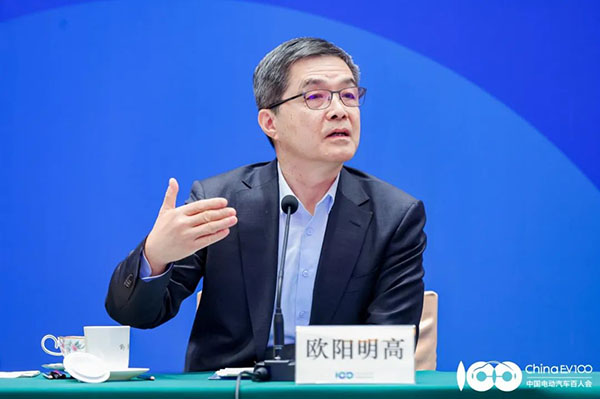2030年新能源汽车保有量会达1亿辆
“从2026年前的短周期趋势来看,新能源汽车市占率将快速提升。今年新能源汽车市场占有率有望增加5-10个百分点,达到36%-41%,乐观情况下有望突破40%。”中国科学院院士、中国电动汽车百人会副理事长欧阳明高,日前在中国电动汽车百人会成果发布会暨百人会论坛(2024)专家媒体交流会上表示。

△图为中国科学院院士、中国电动汽车百人会副理事长欧阳明高主旨发言
欧阳明高预测,2025年中国新能源汽车市占率将接近50%,2026年超过50%,占据汽车市场主导地位。
在全球低碳转型与新能源革命浪潮中,中国快速实现了从跟跑、并跑到领跑的转变。欧阳明高提到,中国去年产销950万辆新能源汽车,8.8亿千瓦时电池,2.9亿千瓦光伏和风电。据中国海关统计,2023年中国电动汽车、锂电池、光伏电池,“新三样”出口1.06万亿元,首次突破万亿元大关。
在新能源汽车方面,欧阳明高预测,到2030年中国的保有量将会达到1亿辆左右,市占率突破70%;在锂离子电池方面,根据国内外机构估计,2030年全球锂离子电池出货量有望达到50亿千瓦时,估计中国占到60%以上,也就是约30亿千瓦时。
从技术角度来看,欧阳明高指出,2030年左右全固态电池技术有望实现产业化;效率超过30%的钙钛矿与晶硅叠层光伏电池有望推广应用;绿色氢能全链条技术有望突破;车网互动与智慧能源系统技术会大规模推广。
“总之,2030我认为是新能源革命的爆发期,新能源电力和新能源汽车会协同发展,新能源汽车带动新能源的发展,新能源反过来又助力电动汽车成为真正的新能源汽车。”欧阳明高判断。
在产业蓬勃发展的同时,欧阳明高也提示要警惕“技术颠覆的风险”。比如固态电池,他指出,固液混合不是颠覆性技术,全固态有颠覆的潜在风险,但还不是现实威胁。我们要居安思危,未雨绸缪,但也不要惊慌,不要焦虑。
“全固态电池的门槛很高,难度很大,切莫急功近利,否则欲速不达。我们国家官产学研对此高度重视,我个人对保持中国电池产业可持续领先优势充满信心。”欧阳明高表示。
Academician Ouyang Minggao: The number of new energy vehicles will reach 100 million by 2030
"Judging from the short cycle trend before 2026, the market share of new energy vehicles will increase rapidly. This year, the market share of new energy vehicles is expected to increase by 5-10 percentage points, reaching 36% -41%, and is expected to exceed 40% in an optimistic situation." Ouyang Minggao, academician of the CAS Member and vice chairman of the China Electric Vehicle 100 People's Association, said at the results conference and expert media exchange meeting of the China Electric Vehicle 100 People's Association Forum (2024).
Academician Ouyang Minggao: The number of new energy vehicles will reach 100 million by 2030
△ The picture shows Ouyang Minggao, academician of the CAS Member and vice chairman of the China Electric Vehicle Hundred People Association, making a keynote speech
Ouyang Minggao predicts that the market share of new energy vehicles in China will approach 50% in 2025 and exceed 50% in 2026, occupying a dominant position in the automotive market.
In the wave of global low-carbon transformation and new energy revolution, China has rapidly achieved a transformation from following and leading. Ouyang Minggao mentioned that China produced and sold 9.5 million new energy vehicles, 880 million kilowatt hour batteries, 290 million kilowatts of photovoltaic and wind power last year. According to Chinese customs statistics, in 2023, China's exports of electric vehicles, lithium batteries, and photovoltaic cells reached 1.06 trillion yuan, breaking the trillion yuan mark for the first time.
In terms of new energy vehicles, Ouyang Minggao predicts that by 2030, China's ownership will reach around 100 million vehicles, with a market share exceeding 70%; In terms of lithium-ion batteries, according to estimates from domestic and foreign institutions, the global shipment of lithium-ion batteries is expected to reach 5 billion kilowatt hours by 2030, with China accounting for over 60%, which is approximately 3 billion kilowatt hours.
From a technical perspective, Ouyang Minggao pointed out that all solid-state battery technology is expected to achieve industrialization around 2030; Perovskite and crystalline silicon stacked photovoltaic cells with efficiency exceeding 30% are expected to be promoted and applied; Green hydrogen energy full chain technology is expected to break through; Vehicle network interaction and smart energy system technology will be widely promoted.
"In short, I believe 2030 is the outbreak period of the new energy revolution, where new energy electricity and new energy vehicles will develop in synergy. New energy vehicles will drive the development of new energy, and new energy will in turn help electric vehicles become true new energy vehicles." Ouyang Minggao judged.
While the industry is flourishing, Ouyang Minggao also reminds us to be vigilant about the risk of technological disruption. For example, solid-state batteries, he pointed out that solid-liquid mixing is not a disruptive technology, and all solid-state batteries have potential risks of disruption, but they are not yet a real threat. We should be prepared for danger in times of peace, but we should not panic or worry.
"The threshold for all solid-state batteries is very high and the difficulty is very high. Do not rush for quick success or instant benefits, otherwise you will not achieve it quickly. Our country's government, industry, academia, and research attach great importance to this, and I am personally confident in maintaining China's sustainable leading advantage in the battery industry." Ouyang Minggao said.

